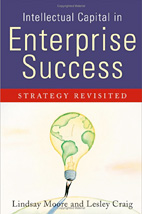Many believe that social capital is an under-leveraged intellectual capital asset which could be powerfully mobilized within both organizations and communities to deliver benefit.
Archives for August 2011
The Strategic Positioning of Intangible Assets (PDF)
Patents, trademarks, copyrights and other intangibles are not worth anything if they sit in isolation. It requires individuals with vision and ability to understand their potential and to turn this into meaningful return by putting in place programmes that will maximise their value.
Tech-Transfer Strategy
Tech-Transfer Strategy. Tech-Transfer as an Industry: Since 1980, the transfer of technologies developed at research universities to private industry has become big business in the U.S. During 2003 alone, tech-transfer revenues approached $1.3 billion, and more importantly, the economic benefits that were derived from the technologies that were transferred into the private sector are estimated to have exceed $41 billion in value.
Patent Portfolios Can Attract Capital
As funds are withdrawn from declining investments, venture capitalists, hedge funds, private equity and institutional investors have substantial holdings to invest in the fundamentals of future market growth.
The Importance of Duty Of Care (PDF)
Exaggerated marketing, false and overblown label claims, adulterated and misbranded products all violate the law, mislead or deceive consumers, and evidence a failure by manufacturers to fulfill the duty of care due consumers.
The Ethics of Intellectual Asset Management (PDF)
The shift from the familiar corporate asset base centered upon traditional physical and financial asset to an asset base centered upon intangible intellectual assets brings with it subtle new ethical challenges and problems.
Brand Valuation Basics
Since the late 1990s, the need to establish dollar valuations for Intellectual Capital Assets has driven the development of a handful of brand valuation methods. Essentially, there are four approaches to valuing a Brand, and one or more of them may be applicable in any individual instance.
The Strategic Significance of Brands
Achieving brand relevance is a strategic task that, by its very nature, is never complete in the volatile markets of our rapidly changing societies. Each and every day more brands enter the marketplace. Ironically, as their numbers increase, there are fewer and fewer brands that really stand for anything significant in the minds of the public.
Brand equity critical in firms’ valuation (PDF)
With the dawn of the Age of Intellectual Capital, during the mid ’90s, came the realization that the real wealth in the modern enterprise is located in the intangible assets of that enterprise—as opposed to the “traditional (tangible) assets” such as real estate, plant, equipment, inventory, cash and the like.



 As the knowledge-based economy expands, the companies and individuals that possess intangible intellectual assets, such as intellectual property, will need specialized expertise, strategic thinking, legal experience, and the wisdom necessary to manage intellectual assets.
As the knowledge-based economy expands, the companies and individuals that possess intangible intellectual assets, such as intellectual property, will need specialized expertise, strategic thinking, legal experience, and the wisdom necessary to manage intellectual assets.